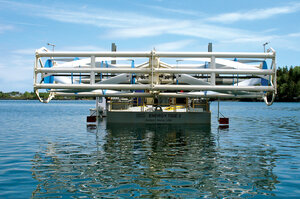Tidal turbines: New sparks of hope for green energy from beneath the waves
After decades of abandoned plans and crushed prototypes, tidal powers finds new footing off the shores of Eastport, Maine.

An underwater generator developed by a Maine firm was tested on riverbeds and the seafloor.
Ocean Renewable Power Company
Eastport, Maine
Eastport is used to being on the fringe of things – the easternmost city in the United States, a remote outpost of Maine's poorest county, and one of the westernmost communities of the Bay of Fundy, home to the world's most dramatic tidal swings.
But in recent years, this community of 1,600 has found itself at the center of an industrial enterprise that its people thought had abandoned them for good: harnessing the tides to generate electricity. Amid Eastport's abandoned sardine factories and often-empty storefronts, engineers have been testing a new generation of tidal turbines that could power the region's homes and businesses without having an adverse effect on the environment, fisheries, or the beautiful views of the forested islands of neighboring Canada.
"It's the Kitty Hawk of tidal energy," says Chris Sauer, president of the Maine-based Ocean Renewable Power Company (ORPC), which has been testing its turbines in the surrounding waters for four years. "You can go anywhere in the world and people know about Eastport."
Tidal power used to be extremely disruptive to the marine environment, as it involved damming a waterway and forcing the currents – and marine life – through conduits housing turbines. Under President Franklin Roosevelt – who summered in the area – construction started on a massive tidal project that would have dammed up local bays, probably dooming the sardine and scallop fisheries on which local people depended. Congress nixed the project for fiscal reasons, though not before a causeway had been built connecting Eastport – previously an island community – to the mainland.
The new tidal technologies are inspired by wind turbines and require no dam. The devices are mounted on the seafloor, where they slowly spin in the current, out of sight and beneath the hulls of passing vessels. Ongoing tests by the University of Maine suggest no effect on marine life, which appear to avoid the devices.
"The tides are about as reliable as anything in nature, so you can predict years in advance how much power you will have at a given time – that's a great advantage," says Paul Jacobson of the Electric Power Research Institute, which released a 2006 survey of North American tidal power sites that jump-started interest in the Bay of Fundy region. "I think 2011 and 2012 are going to be an exciting time because we will have some significant deployments by a couple of US companies."
Until recently, American tidal energy companies were running behind their foreign rivals, whose governments have provided more extensive support. While ORPC was testing a small 60-kilowatt turbine off Eastport last fall, Dublin-based OpenHydro was deploying a two-story-tall one-megawatt device at a government-backed test site off Parrsboro, Nova Scotia, at the head of the Bay of Fundy, where tides reach 50 feet. But the 30-foot-tall device – which resembled the front of a jet engine fan – was no match for the powerful currents there, which tore off its communications devices and at least two of its 16 fan blades.
"Measurements showed there was certainly a lot more energy in the Bay of Fundy than we anticipated, which is a great thing in terms of the potential to harness power from those tides," says Jennifer Parker, a spokesperson for Nova Scotia Power, the provincial utility working with OpenHydro.
Meanwhile, Irving Oil, part of a family-owned conglomerate that dominates the economic and political life of New Brunswick, announced last June it was abandoning its $600,000 tidal energy research project due to "uncertainty around the true viability of tidal technologies."
This has left ORPC – whose devices have met or exceeded expectations – at the forefront of the infant industry. The company plans to deploy a full-scale 150-kilowatt unit off Eastport later this year, intending it to become the first tidal device to be connected to a US electrical grid. In March, they announced plans to deploy a second unit across the Bay of Fundy in Tiverton, Nova Scotia, in 2012. ORPC's design consists of stackable power units tethered to the ocean floor, and both projects are to add additional units by 2015, to a total of more than five megawatts – enough to power about 4,000 homes.
Community engagement was likely vital to ORPC's success in Eastport, a community with a timeworn skepticism about the promises of outside developers. In living memory, the town has seen large projects to build tidal dams, an oil refinery, salmon farms, and, most recently, liquefied natural-gas terminals, come to naught. But ORPC forged partnerships with local divers, fishermen, environmentalists, and business leaders early on.
Today, the company's closest rival is also American. New York-based Verdant Power has for several years been testing its propellerlike turbines in the tidal currents of the East River next to Manhattan, and has applied for federal permits to deploy and grid-connect an array of 30 of them, possibly starting later this year.
"A lot of the initial activity in this industry took place in Europe, but with these projects moving forward in the US, I think the profile of the industry is shifting to some degree to the United States," says Mr. Jacobson.
"It's going to be very interesting," he says, "to see what develops over the coming year."
